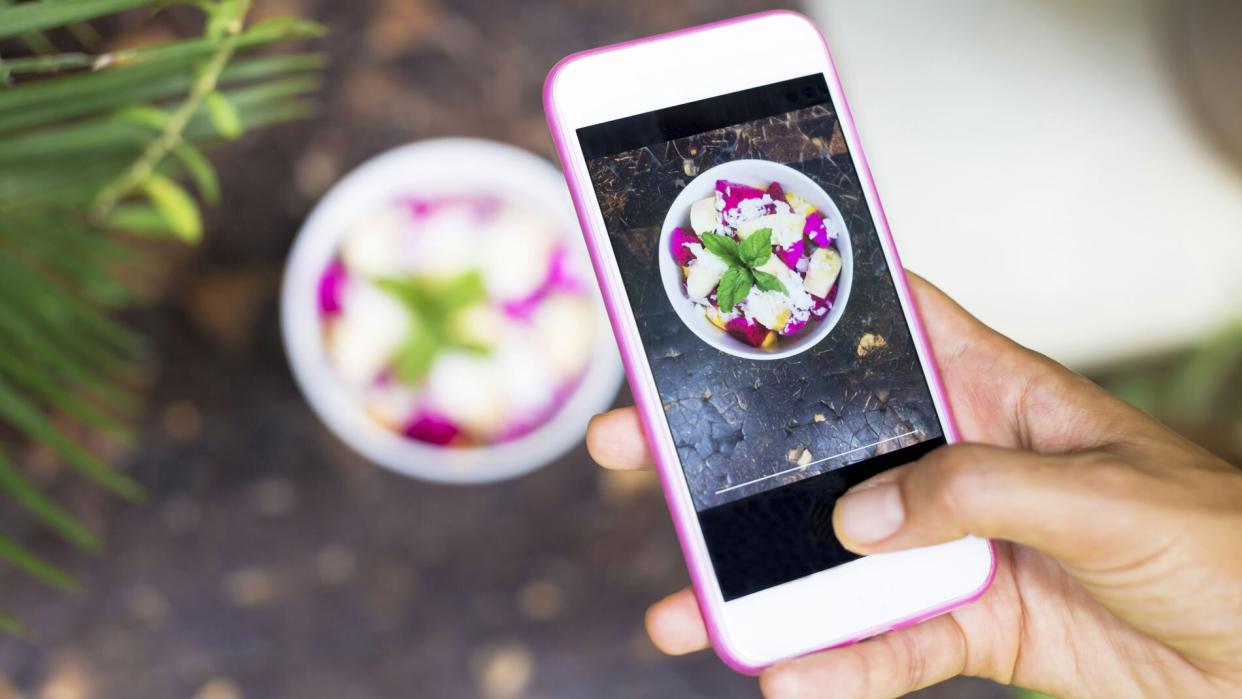Do Restaurants Come Up with Dishes Just for the 'Gram?

Getty Images/Westend61
Barring Soylent and beef stroganoff, appealing presentation has always been—and will always be—a consideration when chefs and bakers and gelato-makers concoct their products. As extreme foods like terrifying, foot-high milkshakes and mermaid grilled cheese gain momentum on photo-sharing apps like Instagram, in turn boosting restaurants' profiles and bringing tangible, IRL business, many people in the food industry have adjusted their menu-planning strategies, asking themselves questions like, "Will this sandwich play well on social media?"
At Clinton Hall, a beer hall with two locations in downtown Manhattan, the restaurant's social media handle @clintonhallNY is written on every table's condiment caddy. Items on their menu like the grilled cheese doughnut—a habanero-glazed bacon donut filled with mozzarella and suspended over a bowl of tomato soup—and the WTF waffles, one of which is garnished with an actual slice of cake, beg to be photographed, if not digested.
Jeremy Lieberman, director of marketing at Clinton Hall, says they didn't concoct the WTF waffles for Instagram, per se—this is an admission almost no one will make—but he does recognize that the plate is exceptionally photogenic, which adds to the fun of eating them, and, hey, if they do well on social, they do well on social.
"Social media has had a profound impact on how restaurants develop dishes," he said. "It used to be the chefs and owners sitting around a table and doing tastings, and now we usually just have our one corporate chef and five to six creatives, who from a marketing and brand perspective say what we think the next trend could be or what may do well on Instagram. In this day and age, content is king."
In a new essay for Eater, "Instagram Food Is a Sad, Sparkly Lie," Amanda Mull unpacks the culture of Instagram influencers and food stunts. "Instagram food has almost nothing to do with consumption as a gastronomic endeavor; instead, consuming Instagram food means acquiring it, and sharing proof of your acquisition," she writes. And some people in the food industry shudder at the cynicism of the content-is-king mentality, yet still benefit from it. Diana Hardeman, the founder and owner of craft ice cream company MilkMade, insists she would never change her ice cream-making approach to adapt to the culture of Instagram foods, though she has mastermind a few herself—namely, her Mermaid Cone, a cone of sweet seaweed ice cream topped with chocolate seashells commemorating Coney Island's Mermaid Parade. The dessert gained significant traction on Instagram.
"We have a philosophy to not just do it for the 'gram," Hardeman said. "There are some photos that we take of the ice cream that of course are 'wow,' and that's always been the case, but we are not just making a product so people can take a photo of it." Before Instagram existed, the company had a strong presence on Tumblr, where Hardeman would post photos of the flavors of the day to get the word out. But the culture today feels different. At MilkMade's relaunch party a few weeks ago, Hardeman gave out free ice cream. One woman asked for the Mermaid Parade cone, and what happened next shook Hardeman to her core.
"I watched her take a photo of it, and then she wanted me to hold it and take a photo of it, and then she was walking off," she said. "I said, 'Do you want your ice cream?' And she said, 'Oh no, I'll just throw it away.' For me, that was a huge insult."
On a somewhat less dramatic scale, chefs and restaurant owners now spend serious time considering whether their dishes will be appealing enough to photograph, which often requires a collaboration between chef and marketing manager.
"It's crazy how much social media has impacted decision-making in the restaurant industry, but it matters," said Hannah Schneider, who recently opened Salt & Vine in Nashville. "I'd let our chef do her thing, create an amazing dish and then as the head of social, I would approach it visually. How do we make this look appealing? Would I sit down and have to take a picture even though I am embarrassed of my own behavior? If the answer is 'yes,' and the flavor is there—it's going on the menu." Schneider, who says her chef would make fun of her for insisting dishes look "Instagrammable," pays specific attention to plating, colors and garnishes.
I was recently walking through Covent Garden in the direction of the Thames when I passed a large crowd that snaked down a cobblestone side street. I spotted fluffy clouds of white cotton candy bopping up and down; the cotton candy was wrapped around soft-serve ice cream cones, topped in Oreo crumbs, chocolate sauce and rainbow candies. Milk Train, the ice cream shop behind the them, called to me, so I waited in the line, bought my cone and took my Instagram.
By the time I'd taken a suitable photo, my hand was coated in melted ice cream and sticky chocolate. The cotton candy was sinking down the cone, so I took a bite of the fluff and threw the rest out. That was the only way I could get to the cone, which was already soggy.

